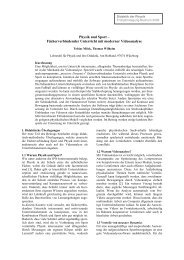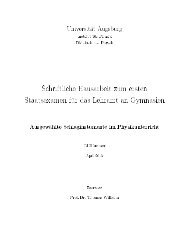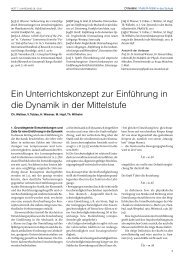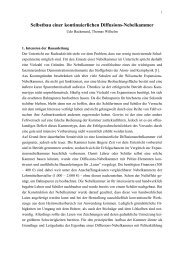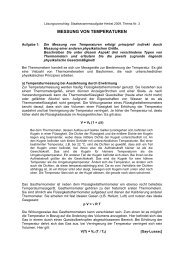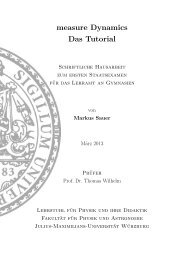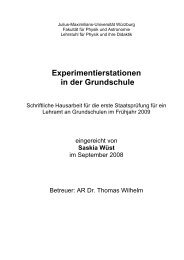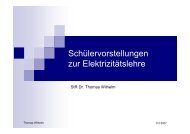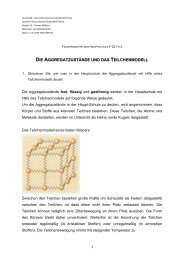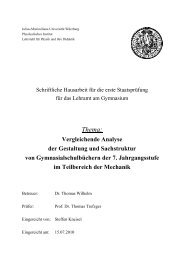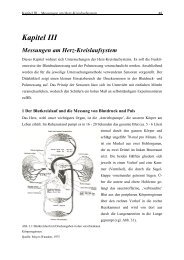Konzeption und Evaluation eines Kinematik/Dynamik-Lehrgangs zur ...
Konzeption und Evaluation eines Kinematik/Dynamik-Lehrgangs zur ...
Konzeption und Evaluation eines Kinematik/Dynamik-Lehrgangs zur ...
Erfolgreiche ePaper selbst erstellen
Machen Sie aus Ihren PDF Publikationen ein blätterbares Flipbook mit unserer einzigartigen Google optimierten e-Paper Software.
266 9 Abstract<br />
on the basis of two-dimensional motions was the essential difference between this teaching concept<br />
and the traditional approach, i.e. the most important, but also the most convincing difference.<br />
The teachers approved that now the sum of all acting forces is emphasised in Newton’s Second Law<br />
� �<br />
with the form a = ΣF<br />
/ m , as this was closer to reality and in reality it is always several forces acting<br />
(chapter 6.3.2). At large, the teachers thought that with this teaching concept, students had <strong>und</strong>erstood<br />
the concept of “force” and mainly the connection with acceleration better than they would<br />
have with the traditional approach. They were of the opinion that the visualisation possibilities, especially<br />
the representation of quantities and their change through vectors, i.e. the dynamic-iconic<br />
representations, influenced learning positively. There was the possibility to show videos of the experiments,<br />
and to have the measurements displayed as a real-time reproduction in PAKMA. This<br />
was used by most teachers with the really complex experiments, and proved good results. This<br />
seems to be the only possibility to efficiently and motivatingly use such new, complex experiments,<br />
which have never been made before, in class. The videos are for visualisation purposes and illustrate<br />
the respective structure and progress of the experiment.<br />
All teachers who used graphic modelling enthused about it (chapter 6.3.3). Two student teachers<br />
used the positive experiences for their written thesis for the Zweite Staatsexamen (Second State<br />
Examination for teachers), and thus showed that the suggested approach is a motivating and expandable<br />
one. Furthermore it turned out to be possible to have networks of variables and relations<br />
created in examination questions.<br />
The teaching concept was well accepted by teachers who are going to teach correspondingly in future<br />
as well. The combination of CD with materials and live presentation can also be seen as a successful<br />
further training event for teachers.<br />
Ideas and materials from this teaching concept, which were originally developed with a view on<br />
physics instruction in classes of Bavarian grammar schools, were used in different contexts and<br />
<strong>und</strong>er different conditions, and that way experience was gained (chapter 7). The introduction of<br />
kinematic quantities by means of general two-dimensional motions attracted great interest and positive<br />
evaluation; it can be realised with various software systems (JPAKMA: chapter 7.1; Coach 5:<br />
chapter 7.3). Many ideas (two-dimensional kinematics, modelling) were used in teacher-focussed<br />
lessons as well as in strongly student-oriented lessons (chapter 7.3.1).<br />
9.5 Empirical comparison of the treatment group with the control groups<br />
Various paper-pencil tests were held in the treatment group, which was instructed pursuant to the<br />
overall concept. It had to be accepted, however, that not all classes took all tests, because due to the<br />
ab<strong>und</strong>ance of subject matter it is difficult for teachers to include a large number of additional tests<br />
in the instruction. The test results were compared with results achieved in traditionally instructed<br />
classes.<br />
In the treatment group, great store was set by the <strong>und</strong>erstanding of kinematic quantities, and twodimensional<br />
motions were dealt with in detail. In traditional instruction, on the other hand, motions<br />
in one dimension with interpretations of graphs were intensively dealt with and practised. With<br />
problems in which the adequate time-velocity graph or time-acceleration graph was to be attributed




